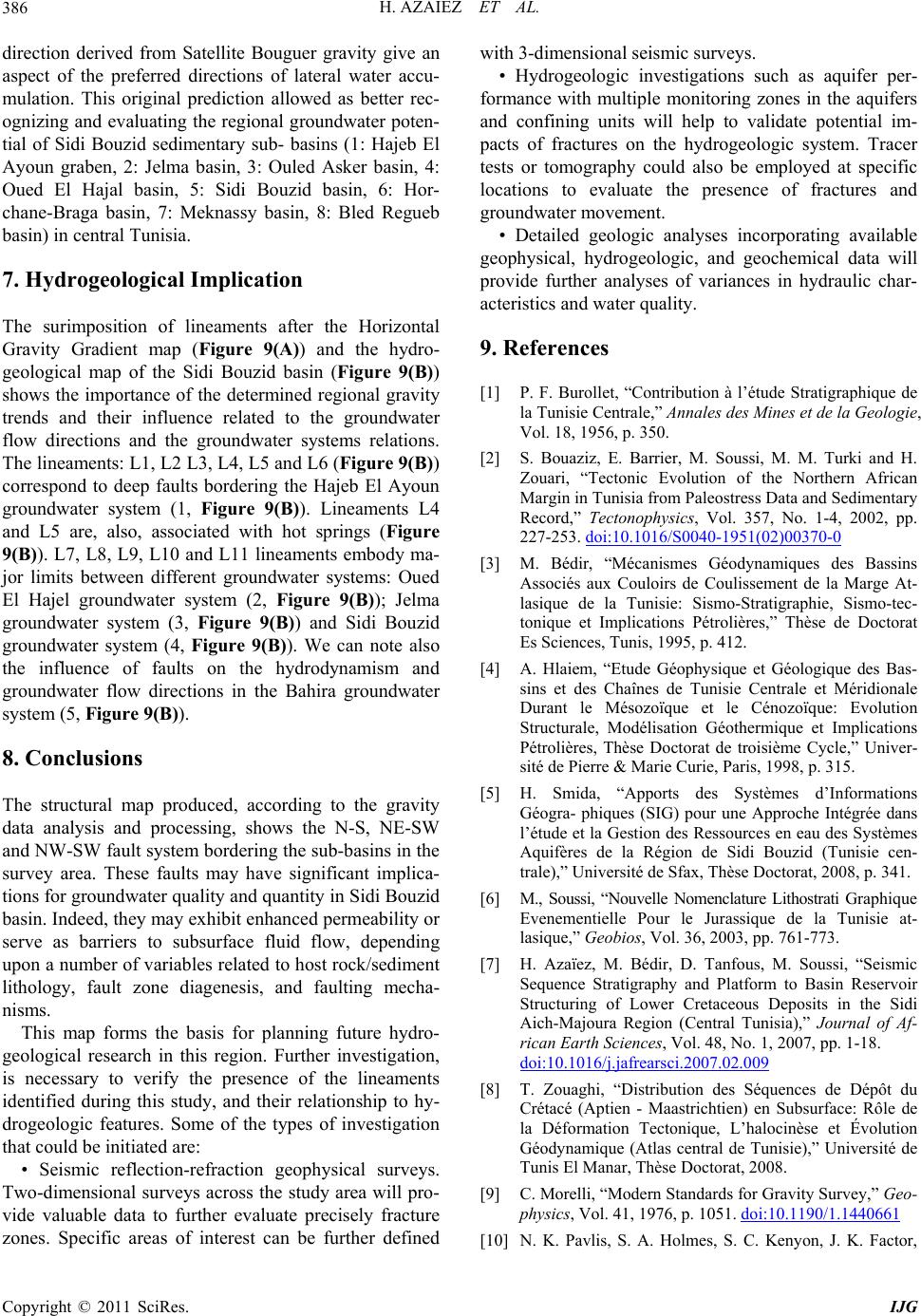
H. AZAIEZ ET AL.
Copyright © 2011 SciRes. IJG
386
direction derived from Satellite Bouguer gravity give an
aspect of the preferred directions of lateral water accu-
mulation. This original prediction allowed as better rec-
ognizing and evaluating the regional groundwater poten-
tial of Sidi Bouzid sedimentary sub- basins (1: Hajeb El
Ayoun graben, 2: Jelma basin, 3: Ouled Asker basin, 4:
Oued El Hajal basin, 5: Sidi Bouzid basin, 6: Hor-
chane-Braga basin, 7: Meknassy basin, 8: Bled Regueb
basin) in central Tunisia.
7. Hydrogeological Implication
The surimposition of lineaments after the Horizontal
Gravity Gradient map (Figure 9(A)) and the hydro-
geological map of the Sidi Bouzid basin (Figure 9(B))
shows the importance of the determined regional gravity
trends and their influence related to the groundwater
flow directions and the groundwater systems relations.
The lineaments: L1, L2 L3, L4, L5 and L6 (Figure 9(B))
correspond to deep faults bordering the Hajeb El Ayoun
groundwater system (1, Figure 9(B)). Lineaments L4
and L5 are, also, associated with hot springs (Figure
9(B)). L7, L8, L9, L10 and L11 lineaments embody ma-
jor limits between different groundwater systems: Oued
El Hajel groundwater system (2, Figure 9(B)); Jelma
groundwater system (3, Figure 9(B)) and Sidi Bouzid
groundwater system (4, Figure 9(B)). We can note also
the influence of faults on the hydrodynamism and
groundwater flow directions in the Bahira groundwater
system (5, Figure 9(B)).
8. Conclusions
The structural map produced, according to the gravity
data analysis and processing, shows the N-S, NE-SW
and NW-SW fault system bordering th e sub-basins in the
survey area. These faults may have significant implica-
tions for groundwater quality and qu antity in Sid i Bouzid
basin. Indeed, they may exh ibit enh anced permeability o r
serve as barriers to subsurface fluid flow, depending
upon a number of variables related to host rock/sediment
lithology, fault zone diagenesis, and faulting mecha-
nisms.
This map forms the basis for planning future hydro-
geological research in this region. Further investigation,
is necessary to verify the presence of the lineaments
identified during this study, and their relationship to hy-
drogeologic features. Some of the types of investigation
that could be initiated are:
• Seismic reflection-refraction geophysical surveys.
Two-dimensional surveys across the study area will pro-
vide valuable data to further evaluate precisely fracture
zones. Specific areas of interest can be further defined
with 3-dimensional sei s mic surveys.
• Hydrogeologic investigations such as aquifer per-
formance with multiple monitoring zones in the aquifers
and confining units will help to validate potential im-
pacts of fractures on the hydrogeologic system. Tracer
tests or tomography could also be employed at specific
locations to evaluate the presence of fractures and
groundwater movement.
• Detailed geologic analyses incorporating available
geophysical, hydrogeologic, and geochemical data will
provide further analyses of variances in hydraulic char-
acteristics and water quality.
9. References
[1] P. F. Burollet, “Contribution à l’étude Stratigraphique de
la Tunisie Centrale,” Annales des Mines et de la Geologie,
Vol. 18, 1956, p. 350.
[2] S. Bouaziz, E. Barrier, M. Soussi, M. M. Turki and H.
Zouari, “Tectonic Evolution of the Northern African
Margin in Tunisia from Paleostress Data and Sedimentary
Record,” Tectonophysics, Vol. 357, No. 1-4, 2002, pp.
227-253. doi:10.1016/S0040-1951(02)00370-0
[3] M. Bédir, “Mécanismes Géodynamiques des Bassins
Associés aux Couloirs de Coulissement de la Marge At-
lasique de la Tunisie: Sismo-Stratigraphie, Sismo-tec-
tonique et Implications Pétrolières,” Thèse de Doctorat
Es Sciences, Tunis, 1995, p. 412.
[4] A. Hlaiem, “Etude Géophysique et Géologique des Bas-
sins et des Chaînes de Tunisie Centrale et Méridionale
Durant le Mésozoïque et le Cénozoïque: Evolution
Structurale, Modélisation Géothermique et Implications
Pétrolières, Thèse Doctorat de troisième Cycle,” Univer-
sité de Pierre & Marie Curie, Paris, 1998, p. 315.
[5] H. Smida, “Apports des Systèmes d’Informations
Géogra- phiques (SIG) pour une Approche Intégrée dans
l’étude et la Gestion des Ressources en eau des Systèmes
Aquifères de la Région de Sidi Bouzid (Tunisie cen-
trale),” Université de Sfax, Thèse Doctorat, 2008, p. 341.
[6] M., Soussi, “Nouvelle Nomenclature Lithostrati Graphique
Evenementielle Pour le Jurassique de la Tunisie at-
lasique,” Geobios, Vol. 36, 2003, pp. 761-773.
[7] H. Azaïez, M. Bédir, D. Tanfous, M. Soussi, “Seismic
Sequence Stratigraphy and Platform to Basin Reservoir
Structuring of Lower Cretaceous Deposits in the Sidi
Aich-Majoura Region (Central Tunisia),” Journal of Af-
rican Earth Sciences, Vol. 48, No. 1, 2007, pp. 1-18.
doi:10.1016/j.jafrearsci.2007.02.009
[8] T. Zouaghi, “Distribution des Séquences de Dépôt du
Crétacé (Aptien - Maastrichtien) en Subsurface: Rôle de
la Déformation Tectonique, L’halocinèse et Évolution
Géodynamique (Atlas central de Tunisie),” Université de
Tunis El Manar, Thèse Doctorat, 2008.
[9] C. Morelli, “Modern St anda rds for Gravity Survey,” Geo-
physics, Vol. 41, 1976, p. 1051. doi:10.1190/1.1440661
[10] N. K. Pavlis, S. A. Holmes, S. C. Kenyon, J. K. Factor,